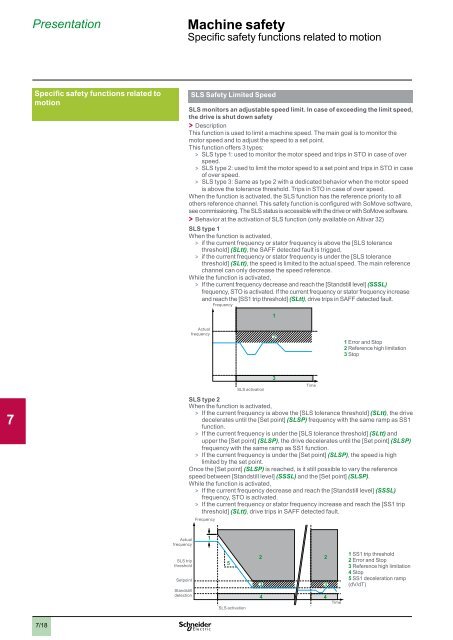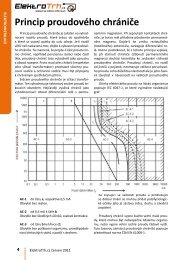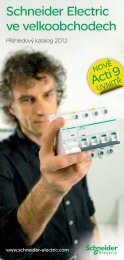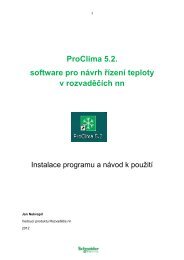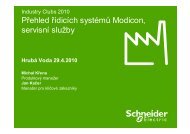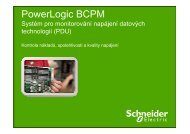2 - Schneider Electric CZ, s.r.o.
2 - Schneider Electric CZ, s.r.o.
2 - Schneider Electric CZ, s.r.o.
You also want an ePaper? Increase the reach of your titles
YUMPU automatically turns print PDFs into web optimized ePapers that Google loves.
Presentation<br />
Machine safety<br />
Specific safety functions related to motion<br />
1<br />
2<br />
3<br />
4<br />
5<br />
6<br />
7<br />
8<br />
9<br />
10<br />
Specific safety functions related to<br />
motion<br />
SLS Safety Limited Speed<br />
SLS monitors an adjustable speed limit. In case of exceeding the limit speed,<br />
the drive is shut down safety<br />
> > Description<br />
This function is used to limit a machine speed. The main goal is to monitor the<br />
motor speed and to adjust the speed to a set point.<br />
This function offers 3 types:<br />
> > SLS type 1: used to monitor the motor speed and trips in STO in case of over<br />
speed.<br />
> > SLS type 2: used to limit the motor speed to a set point and trips in STO in case<br />
of over speed.<br />
> > SLS type 3: Same as type 2 with a dedicated behavior when the motor speed<br />
is above the tolerance threshold. Trips in STO in case of over speed.<br />
When the function is activated, the SLS function has the reference priority to all<br />
others reference channel. This safety function is configured with SoMove software,<br />
see commissioning..The SLS status is accessible with the drive or with SoMove software.<br />
> > Behavior at the activation of SLS function (only available on Altivar 32)<br />
SLS type 1<br />
When the function is activated,<br />
> > if the current frequency or stator frequency is above the [SLS tolerance<br />
threshold] (SLtt), the SAFF detected fault is trigged,<br />
> > if the current frequency or stator frequency is under the [SLS tolerance<br />
threshold] (SLtt), the speed is limited to the actual speed. The main reference<br />
channel can only decrease the speed reference.<br />
While the function is activated,<br />
> > If the current frequency decrease and reach the [Standstill level] (SSSL)<br />
frequency, STO is activated..If the current frequency or stator frequency increase<br />
and reach the [SS1 trip threshold] (SLtt), drive trips in SAFF detected fault.<br />
Frequency<br />
Actual.<br />
frequency<br />
SLS trip<br />
threshold<br />
Setpoint<br />
Standstill<br />
detection<br />
Actual.<br />
frequency<br />
SLS activation<br />
1<br />
2<br />
3<br />
Time<br />
1 Error and Stop<br />
2 Reference high limitation<br />
3 Stop<br />
SLS type 2<br />
When the function is activated,<br />
> > If the current frequency is above the [SLS tolerance threshold] (SLtt), the drive<br />
decelerates until the [Set point] (SLSP) frequency with the same ramp as SS1<br />
function.<br />
> > If the current frequency is under the [SLS tolerance threshold] (SLtt) and<br />
upper the [Set point] (SLSP), the drive decelerates until the [Set point] (SLSP)<br />
frequency with the same ramp as SS1 function.<br />
> > If the current frequency is under the [Set point] (SLSP), the speed is high<br />
limited by the set point.<br />
Once the [Set point] (SLSP) is reached, is it still possible to vary the reference<br />
speed between [Standstill level] (SSSL) and the [Set point] (SLSP).<br />
While the function is activated,<br />
> > If the current frequency decrease and reach the [Standstill level] (SSSL)<br />
frequency, STO is activated.<br />
> > If the current frequency or stator frequency increase and reach the [SS1 trip<br />
threshold] (SLtt), drive trips in SAFF detected fault.<br />
Frequency<br />
1<br />
5<br />
SLS activation<br />
2<br />
3 3<br />
4<br />
2<br />
4<br />
Time<br />
1 SS1 trip threshold<br />
2 Error and Stop<br />
3 Reference high limitation<br />
4 Stop<br />
5 SS1 deceleration ramp<br />
(dV/dT)<br />
7/18


